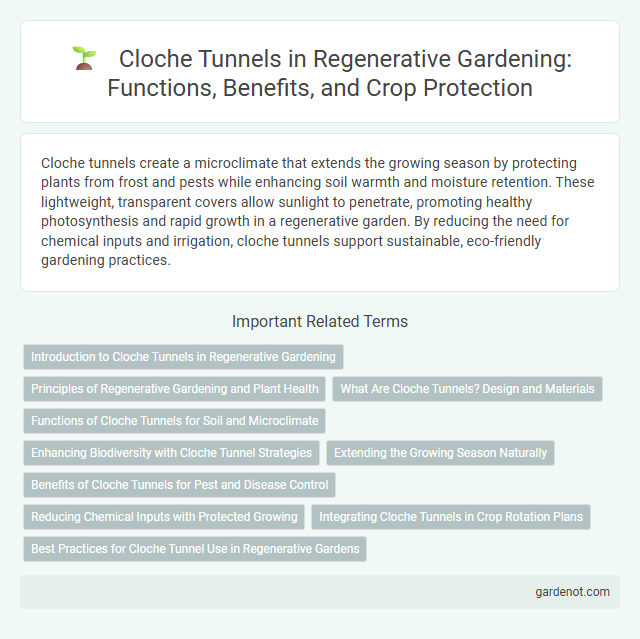Cloche tunnels create a microclimate that extends the growing season by protecting plants from frost and pests while enhancing soil warmth and moisture retention. These lightweight, transparent covers allow sunlight to penetrate, promoting healthy photosynthesis and rapid growth in a regenerative garden. By reducing the need for chemical inputs and irrigation, cloche tunnels support sustainable, eco-friendly gardening practices.
Introduction to Cloche Tunnels in Regenerative Gardening
Cloche tunnels create a microclimate essential for extending the growing season in regenerative gardening by trapping heat and protecting plants from frost. These structures typically consist of low, curved frames covered with transparent materials, enhancing soil warmth and moisture retention. Utilizing cloche tunnels supports resilient plant growth while reducing the need for chemical interventions, aligning with sustainable and regenerative garden practices.
Principles of Regenerative Gardening and Plant Health
Cloche tunnels create a microclimate that aligns with the principles of regenerative gardening by enhancing soil vitality and supporting biodiversity. These structures protect young plants from harsh weather and pests, promoting robust plant health through natural temperature regulation and moisture retention. By encouraging stronger root systems and reducing the need for chemical interventions, cloche tunnels contribute to sustainable, resilient garden ecosystems.
What Are Cloche Tunnels? Design and Materials
Cloche tunnels are protective structures used in regenerative gardening to extend the growing season by creating a microclimate that retains warmth and moisture around plants. Typically constructed from lightweight materials such as polyethylene film or UV-resistant plastic over a series of flexible hoops, cloche tunnels shield crops from frost, pests, and harsh weather conditions. Their design facilitates easy installation and ventilation adjustments, optimizing plant growth while maintaining soil health.
Functions of Cloche Tunnels for Soil and Microclimate
Cloche tunnels create a protected microclimate by trapping heat and moisture, which enhances soil temperature and accelerates seed germination. They reduce soil evaporation and shield plants from frost, extend the growing season, and promote healthier root development. This controlled environment supports beneficial microbial activity, improving soil fertility and plant resilience.
Enhancing Biodiversity with Cloche Tunnel Strategies
Cloche tunnels create microclimates that extend growing seasons and protect delicate plants, fostering diverse ecosystems in regenerative gardens. By maintaining consistent humidity and temperature, these structures support beneficial insects and soil microbes vital for plant health. Implementing cloche tunnels strategically maximizes biodiversity, promoting resilient, sustainable garden environments.
Extending the Growing Season Naturally
Cloche tunnels create a microclimate that traps heat and protects plants from frost, effectively extending the growing season in regenerative gardens. By using transparent materials like polyethylene, these tunnels allow sunlight to penetrate while maintaining warmth and moisture levels for optimal plant growth. This natural extension reduces the need for artificial heating and supports sustainable, year-round food production.
Benefits of Cloche Tunnels for Pest and Disease Control
Cloche tunnels create a controlled microenvironment that significantly reduces the risk of pest infestations and plant diseases by acting as a physical barrier against insects and pathogens. This protective covering maintains optimal humidity and temperature levels, promoting healthier plant growth and increasing resistance to stress. By minimizing the need for chemical pesticides, cloche tunnels support sustainable gardening practices and enhance soil health in regenerative gardens.
Reducing Chemical Inputs with Protected Growing
Cloche tunnels create a controlled microclimate that significantly reduces the need for chemical pesticides and herbicides by protecting plants from pests and extreme weather. This method of protected growing boosts plant health and resilience, minimizing chemical inputs while promoting organic growth. Utilizing cloche tunnels supports sustainable gardening practices by enhancing crop yield and quality without environmental harm.
Integrating Cloche Tunnels in Crop Rotation Plans
Integrating cloche tunnels in crop rotation plans enhances soil protection and microclimate regulation, promoting early seedling growth and extending harvest periods. These tunnels create ideal conditions for temperature-sensitive crops, reducing pest pressure and improving nutrient cycling within regenerative garden systems. Proper placement and timing within rotation cycles maximize benefits, supporting healthy soil biology and increased crop yields.
Best Practices for Cloche Tunnel Use in Regenerative Gardens
Maintaining optimal soil moisture and temperature is essential for successful cloche tunnel use in regenerative gardens, promoting early seed germination and extended growing seasons. Employing breathable, UV-resistant materials and ensuring proper ventilation prevents overheating and fungal growth while enhancing plant health. Regular monitoring and rotating crops within cloche tunnels support soil biodiversity and sustainable garden productivity.
Cloche tunnel Infographic

 gardenot.com
gardenot.com